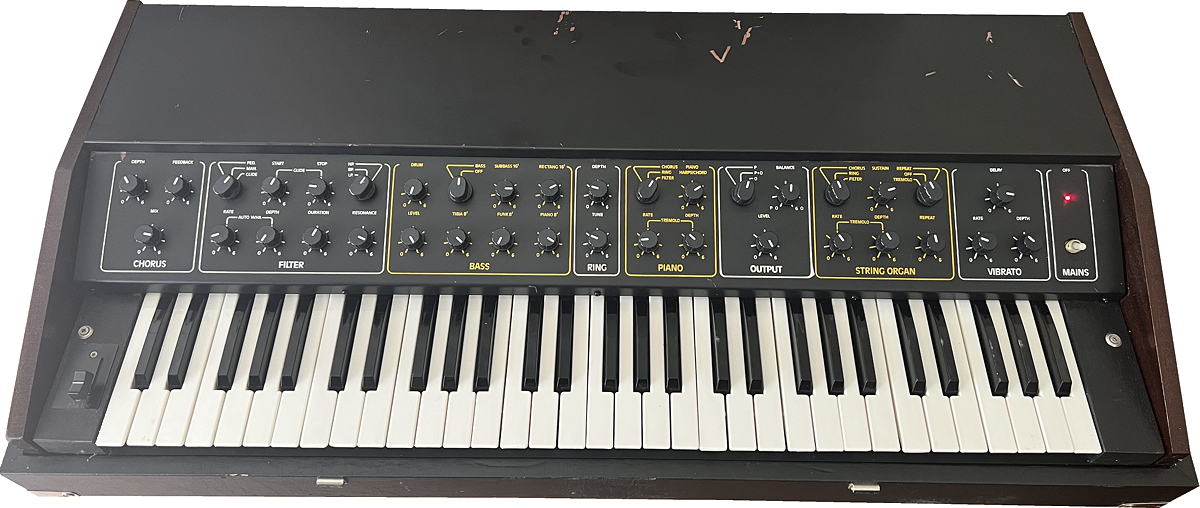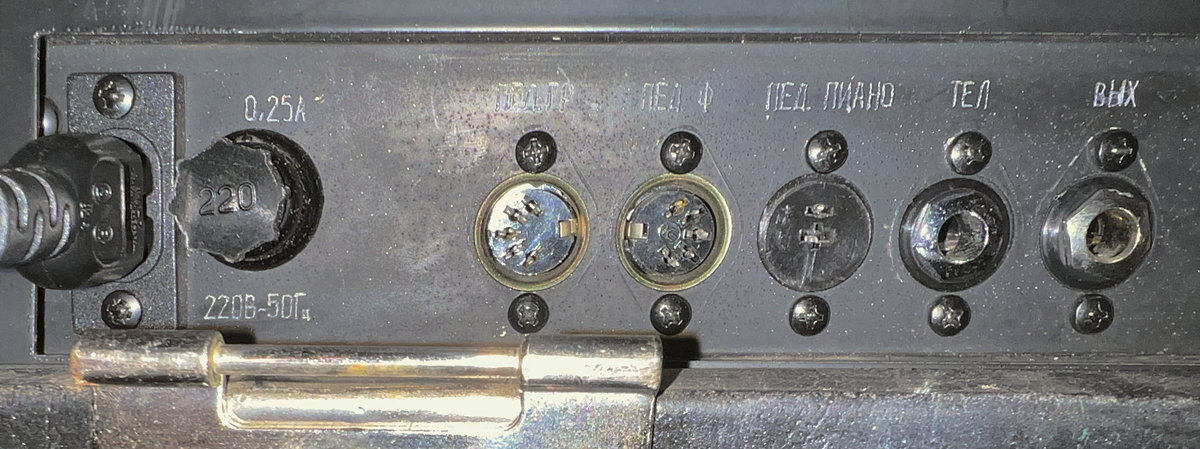
When I watched RetroSound's Videos (see below for links), I was flashed by this sound of the RMIF/РМИФ (Rīgas Mūzikas Instrumentu Fabrika) OPUS/Oпус. It was released in two different versions. One with a phaser [ext. pic], and the one shown above with a Chorus. It was built at the end of the eigthies in Riga USSR, today the capital of Latvia. This keyboard uses divide down technology as used for most string keyboards. Therefor it is full polyphonic. The chorus, ringmodulator and filter are not per note but global for all voices at once.
There are three sound generating sections:
- Bass: may used on the lower two octaves in a split mode
- Piano: not hyper realistic at all
- String Organ: think 70ies string keyboard
The Bass section is either set off or on with a two stop rotary switch. When switched on, the bass section, and only the bass section is played on the lowest two octaves. The settings are very special. You have a master section volume labeled Level. And you can mix in six different bass sounds here: the Drum part sounds a bit like a dull bass drum with some low filtered noise. The Subbass 16" and Rectang(ular) 16" are obvious. Tibea 8" is a muted sound with some volume attack time. Funk 8" is a brighter sound. Piano 8" is a short decaying sound, but not sounding like a piano at all.
Piano section let you route its sound to either the chorus, ringmodulator or filter. The pot labeled "Piano Harpsichord" changes the sound from dull to bright. The notes have a fixed decay setting. Also included in this section is a tremolo LFO with rate and depth pots.
Finally the String Organ section is routed to chorus, ringmodulator and filter just like the Piano section. There is also a tremolo LFO with two pots here as on the piano section. The Sustain pot is setting the release time of notes no longer pressed. The usage of the word "sustain" and not the todays therm "release" is typical for organs from the last century. A second three stop rotary switch let you switch the repeat (auto trigger function) on or the tremlo. Or switches both off. A Repeat labeled pot adjust the rate of the repeat function.
You can route the Piano and String Organ section individually to the built in Chorus, the built in Ringmodulator or the multimode filter. The Chorus gives you modulation rate, depth of modulation and a wet/dry knob. Like all knobs, the pot scale on the panel is labeled 0 to 6. The Ringmodulator got a rather coarse tune pot for the steady internal oscillator and a wet/dry knob. The Filter got three modes: highpass, bandpass and lowpass. The cutoff is labeled Start here. The envelope modulation amount is named Stop. And the simple envelope is only a variable decay labeled Duration. The resonance is working like expected. The Auto Wha (yes, labeled like this!) is a LFO with a rate and depth pot working on the cutoff frequency. The three stop switch selects if the foot pedal modulates the cutoff, or the simple decay envelope. Or without modulation of these two. The sound character is a special one with lot of colouration. Used with plenty resonance and in highpass mode on the piano section with a more brighter harpsichord like setting, gives some nice synthesizer like filter sweeps. Of cause, there is only one filter for all voices.
The Vibrato section is an LFO with rate and modulation depth pots. And a Delay parameter to fade in the vibrato. But this is not working per key, but starts from the first note pressed. The vibrato is working on all sections simultaneously.
The Output is a bit special, beside the obvious Level for master volume. The three stop rotary switch let you select if the Piano or the String Organ or both are routed to the outputs. And you can adjust the Piano to String Organ volume ratio with one pot here.
On the left end of the keybed is a slider labeled Pitch Bend. It let you slide about one octave upwards. And just next to this slider is a hole. You can see a trimpot here to adjust the Pitchbender range (?).
And there is a big white mains switch with a red LED above to switch this instrument on/off.

The backside connections from left to right:
| • | Power cord | here modified for a C8 socket in favour of a non-detachable power cord |
| • | Main fuse 0.25A for 220V, 50Hz | 220В 50Гц = 220V, 50Hz |
| • | 5-pin DIN filter pedal socket | ПЕД. ГР = PED. GR |
| • | 5-pin DIN volume pedal socket | ПЕД. Ф = PED. F |
| • | DIN 41529 two pole socket for piano sustain pedal | ПЕД. ПИАНО = PED. PIANO |
| • | Phones socket modified as 1/4" in favour of 5-pin DIN socket | ТЕЛ (short for ТЕЛЕФОНЫ) = PHONES |
| • | Audio out modified as 1/4" in favour of 5-pin DIN socket | ВЫХ = OUT |
Videos by RetroSound
Here are some good videos showing the OPUS played:
